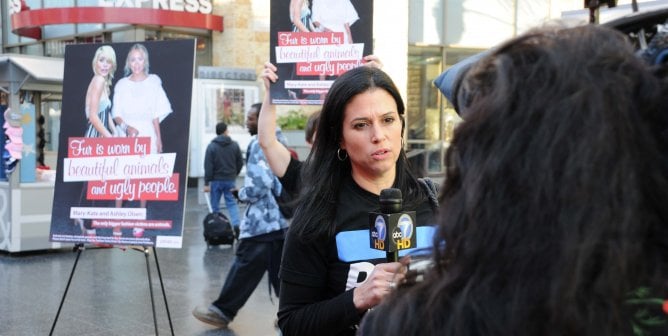PETA Plans Elephant Statue for Baraboo Public Art Project
Group Offers Famed ‘Elly Wanna B. Free’ Statue to Shed Light on Circus Cruelty
For Immediate Release:
February 28, 2018
Contact:
David Perle 202-483-7382
After learning that the Baraboo Public Art Association is looking to add a second elephant statue to its public art project, PETA sent a letter today offering to send the life-size “Elly Wanna B. Free” (aka “Ella”) statue, which was designed by New Yorker cartoonist Henry Bliss and currently resides outside PETA’s Washington, D.C., office. “Ella” has appeared in public art projects in D.C. and Rochester, New York, to inform people that animals in circuses are routinely beaten, whipped, and shocked into performing tricks.
“Ella sends the message that everyone can make a difference for animals simply by making kind choices,” says PETA Foundation Associate Director Rachel Mathews. “The Baraboo Public Art Association now has a unique opportunity to show the hidden side of circuses with PETA’s thought-provoking elephant statue.”
PETA’s motto reads, in part, that “animals are not ours to use for entertainment.” For more information, please visit PETA.org.
PETA’s letter to Baraboo Public Art Association Board Member Marcy Huffaker follows.
February 28, 2018
Marcy Huffaker
Board Member
Baraboo Public Art Association
Dear Ms. Huffaker,
I’m writing on behalf of People for the Ethical Treatment of Animals (PETA) and our more than 6.5 million members and supporters worldwide, including more than 68,000 across Wisconsin, to initiate discussions about including an elephant statue in the Baraboo Public Art Association’s public art project. “Elly Wanna B. Free” (aka “Ella”) is a full-size elephant statue that is a perfect emblem of the times and has graced cities from Washington, D.C., to Rochester, New York, as part of other public art projects.
Ella—designed by noted New Yorker cover artist and cartoonist Harry Bliss—is shackled, and her tears remind visitors about the cruelty of circuses that use elephants.
Instead of being allowed to roam in herds and socialize—that is, simply to be elephants—these magnificent animals are chained, beaten, and dragged from city to city to balance on balls, do headstands, and perform other confusing, often painful tricks. Ella represents every elephant who has suffered for entertainment and should now be retired to sanctuaries, away from bullhooks and boxcars.
Ella has gone over big in D.C., and we know that she’ll be a fan favorite in Baraboo, too. Tourists line up for photographs with her, while schoolchildren learn about empathy and respect for all beings during story time with her. She receives postcards from kids all around the world.
Animal circuses are now mostly a thing of the past. Ringling Bros. and Barnum & Bailey Circus shut down after 146 years, Cole Bros. Circus is no longer touring, Kelly Miller and Ramos Bros. circuses dropped all wild-animal acts, and more than 620 malls and 70 cities and jurisdictions now restrict performances that use animals. But it’s still critical that we teach our children the history of the circus so that history doesn’t repeat itself.
We would cover the costs to include Ella—with her message that all of us can make a difference with kind choices—in Myron Park’s budding pachyderm parade. I look forward to discussing this idea with you.
Sincerely,
John Di Leonardo
Assistant Manager, Animals in Entertainment
People for the Ethical Treatment of Animals


